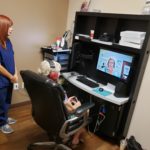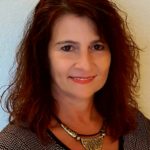
A patient in a tele-audiology session. Dr. Younker says, thanks to telemedicine, it’s easier than ever to incorporate audiology screening in your practice.
By Justin Manning, OD, MPH, FAAO,
and Suzanne Younker, AuD, CCC-A, FAAA
Oct. 6, 2021
When thinking about how you can better the lives of patients, there is a service you may be overlooking because it is not related to the eyes: Audiology.
Optometrists are not trained to deliver audiology services, but bringing these services into your practice by partnering with a trained expert is not as hard as you think, thanks to telemedicine, and can spur practice growth, bringing patients through your doors who need both vision and hearing help.
The need for audiology services is great. One-in-eight people in the U.S. (13 percent, or 30 million) aged 12 years or older has hearing loss in both ears, based on standard hearing examinations, according to the National Institute on Deafness and Other Communication Disorders.
Review of Optometric Business recently learned from Justin Manning, OD, MPH, FAAO, executive vice-president of professional strategies at Healthy Eyes Advantage (HEA), and Suzanne Younker, AuD, CCC-A, FAAA, Director of Telehealth at Your Hearing Network, how optometrists can make audiology services a part of their practice.
Many Patients With Hearing Loss Also Have Impaired Vision
SY: The population demographic of 65+ is growing significantly every year in the U.S. Of this population, approximately 17 million Americans experience hearing loss that is significant enough to impact their quality of life.
Of those with hearing loss, approximately 9 million also experience significant vision loss doubling the negative consequences on quality of life. Studies have shown that patients who experience untreated dual vision and hearing impairments are twice as likely to develop dementia, three times more likely to fall with injuries; and become socially isolated leading to depression. Physical disability measured by Activities of Daily Living Scale (IADL) supports these studies. ODs have an opportunity to be a hero to their vision patients by offering hearing healthcare in their practices
How Do I Make Audiology Services a Part of My Practice?
SY: The traditional method of incorporating audiology services into a vision practice has been done by housing an audiologist on-site in the practice. The best way to solicit this arrangement would be to advertise to the audiology community through a state professional audiology association and through online recruiting services.
A more modern approach to adding hearing care to a vision practice is by utilizing TeleAudiology. With TeleAudiology, the audiologist does not need to be on-site to accomplish the same level of full-service quality hearing care. With TeleAudiology, the availability of hearing care services can be customized to the OD practice’s schedule and existing employee resources can be shared with minimal burden on the vision practice. There are companies that specialize in providing “turnkey” TeleAudiology implementation and management services, such as Your Hearing Network’s Tele Care services.
What Is the Profitability Opportunity of Adding Audiology Services?
SY: The cost of adding audiology services to a practice varies greatly and depends on the arrangement the OD practice has with the audiologist. An OD practice can purchase hearing care equipment and hire an audiologist or rent space to an audiologist, who obtains the equipment and then runs the department as a private practice.
Thanks to modern telehealth methodology and technology, TeleAudiology offers a unique opportunity to have hearing care at a minimal or no risk financial and resource investment. TeleAudiology management companies have programs in which they completely support audiology services including taking care of equipment installation and employing the TeleAudiologist. In this instance, the OD practice provides the space (a quiet room) and an optical technician who is cross-trained as an TeleAudiology facilitator, to assist the TeleAudiologist in facilitating the hearing care services. In this model, patients still come to the practice by appointment and receive the hearing services in real time with a TeleAudiologist and with the assistance of the facilitator.
Profitability is dependent on the arrangement made with the audiologist. Revenue from renting space can generate a couple thousand dollars a month and has the least financial risk. Employing an audiologist and investing in the equipment has the most financial risk, however, has the most opportunity for significant increase in revenue.
In a TeleAudiology arrangement as described above, using a management company minimizes the financial risk to the OD practice and increases revenue a minimum of $10,000 per month.
How Do I Market Audiology Services?
JM: Once a practice begins offering hearing services, it is critically important to communicate this new benefit to current and future patients. First, pull your patient e-mail list based on age to set up an e-blast. While patients age 65+ are at the highest risk for hearing lost, I’d recommend beginning with patients age 50 and older, when the risk begins to develop. For those in their early 50s, it will serve to bring awareness of their risk as they get older and that they can receive these hearing care services in your office. In addition, these early 50s patients likely have living parents and family members who are 70+ and may already be patients.
Even if the younger patients do not need hearing care, they are likely to recommend the services to their parents and other family members. The convenience of receiving both services during a single visit can drive those caregivers to bring their family members in.
Other Articles to Explore
It is important to set up a hearing care page on your practice website to promote the services you deliver. Make sure the language and images represent and communicate to the patients you want to attract for these services. In addition, be sure to promote these services on your social media platforms, and consider sponsored posts. It is important to choose wisely which social media platforms to promote this on.
Baby Boomers are highly active on Facebook and LinkedIn and are often active on Instagram as well. This population and the silent generation (age 75+) are at the highest risk for hearing loss. Even silent generation patients are active on Facebook. Your messaging on Facebook should highlight the hearing problems they are likely experiencing. Generation X patients are most active on YouTube and Facebook. For these patients (children of those patients with high risk), make sure your messaging is appropriate to encourage them to bring their parents in for hearing care.
Move Your Practice Further Into the “Experience Economy” with Audiology Services
SY: The relationship between vision and hearing is not a new idea; it was popular about 40 years ago. Today, it is not common and can be considered a differentiator. With today’s healthcare environment moving toward multi-professional wellness centers, combining optometry and audiology is likely to see a resurgence.
By incorporating hearing care into an existing vision care practice, patients feel they are being treated holistically and by a trusted source since they have already established a relationship with their vision care staff.
JM: Independent ODs operate within an experience economy, where patients/customers are loyal to practices that provide a great experience. This is driven by value, ease of access and level of enjoyment. Providing hearing care alongside optometric care provides greater value to their experience in your practice. You will have the opportunity to capture eyecare patients who initially present just for hearing care, but who then will take the opportunity while in your office to also have their vision and eye health evaluated.
 Justin Manning, OD, MPH, FAAO, is the executive vice-president of professional strategies at Healthy Eyes Advantage (HEA). He can be reached at JManningOD@hea2020.com.
Justin Manning, OD, MPH, FAAO, is the executive vice-president of professional strategies at Healthy Eyes Advantage (HEA). He can be reached at JManningOD@hea2020.com.
 Suzanne Younker, AuD, CCC-A, FAAA, is Director of Telehealth at Your Hearing Network. She can be reached at: suyo@yourhearingnetwork.com
Suzanne Younker, AuD, CCC-A, FAAA, is Director of Telehealth at Your Hearing Network. She can be reached at: suyo@yourhearingnetwork.com





















